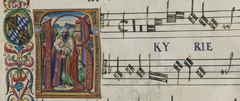Digitized Choirbooks at the Bavarian State Library
Veronika Giglberger, Bernhard Lutz
Wednesday, January 16, 2013

The Bayerische Staatsbibliothek (BSB; Bavarian State Library) is currently digitizing its collection of 165 choirbooks containing polyphonic music from the sixteenth and seventeenth centuries, most of which are large and lavishly decorated. Begun in December 2012 and funded by the German Research Foundation (DFG) over the course of three years, this project aims to catalog, digitize, and provide online access to these manuscripts, which are of worldwide importance.
As successor to the court library of the dukes, electors, and kings of Bavaria, the BSB has been collecting music since the time of Duke Albert V (reigned 1550 – 1579) due to his special interest in the art. Under the rule of Albert, Munich became one of the most significant musical centers of Europe with the appointment of Orlando di Lasso as court musician. Proof of this can be seen in the choirbook tradition that was cultivated to an exceptional degree, in addition to the distinguished collection of printed music from the sixteenth and seventeenth centuries. The term choirbook signifies a source containing vocal music in which several voice parts are depicted on one or two facing pages. This notational system arose over the course of the development of polyphony in vocal music and long before the establishment of today’s usual arrangement of polyphonic music in scores. The earliest manuscripts in choirbook-like notation date from around 1400, major examples are from the sixteenth and seventeenth centuries, and the last examples of this kind appeared well into the eighteenth century.
According to the BSB’s Institute for Book and Manuscript Restoration, digitizing the sources presents the most effective way of preserving the collection. In some cases, loss of text results from brittle pieces of paper breaking off with each turn of the page. Within the entire collection, eleven codices are no longer accessible to researchers due to their fragile condition and 26 may be consulted only in the presence of a conservator. Some of the most valuable sources have additionally been affected by the ongoing process of ink corrosion through heavy use, as access to the originals in cases of specific inquiries could not be avoided.
The usual catalog data, which has already been recorded, will be entered in the database Kallisto and transferred to the RISM online catalog. The catalog was newly developed by the BSB in cooperation with RISM and the Staatsbibliothek zu Berlin Preußischer Kulturbesitz. The data will be thoroughly edited and linked, for the numerous new search possibilities are essential for research.
The BSB will soon be able to provide their entire core collection of historical musical sources online through this and another large-scale project to digitize musical prints from the same era, which is also funded by the DFG. Today there are 58 choirbooks and around 400 music prints from both projects already available through the digital library.
Share Tweet EmailCatégorie: Collections de bibliothèques

